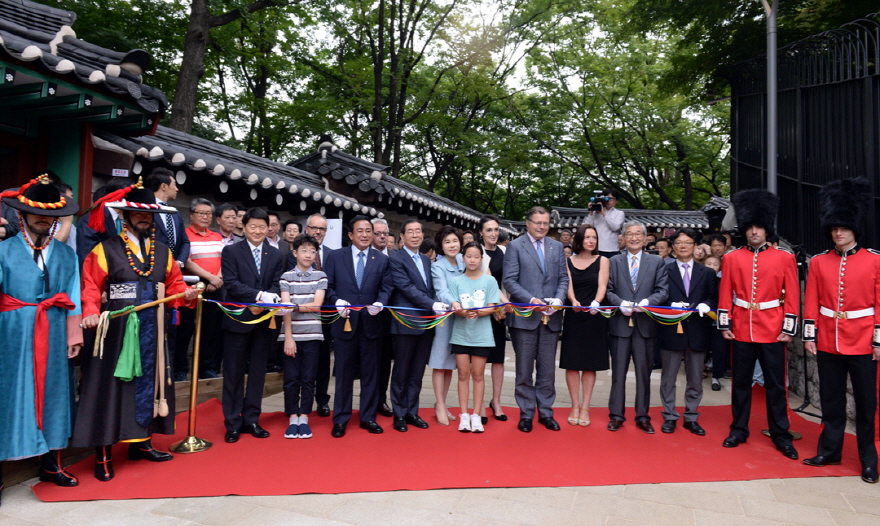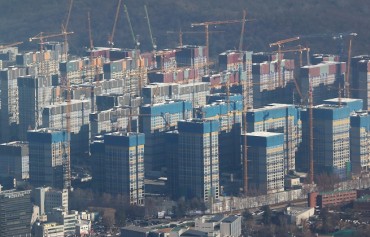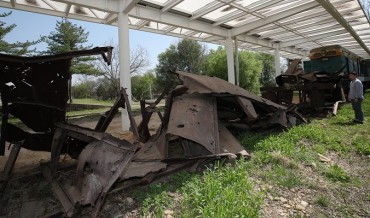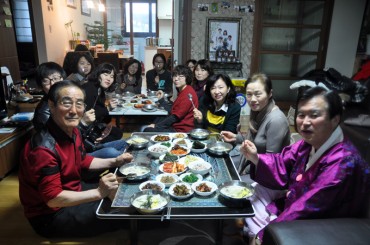SEOUL, Sept. 21 (Korea Bizwire) — About 100 years after the death of King Gojong, the penultimate ruler of Korea’s last kingdom of Joseon, his royal residence, Deoksu Palace, provides a rare scenic retreat for modern Koreans at the very bustling heart of the capital Seoul.
A 1.1-kilometer stone-paved path along the stone wall that encircles the compound of Deoksu Palace is an especially beloved scenic walkway, taking visitors back to the long-gone era of the kingdom.
A popular saying is that any couple who strolls along the stone wall path, also known as Doldamgil, is bound to break up, an urban myth possibly stemming from when the Seoul Family Court in charge of divorce cases adjoined the road.
But the story could also be traced back to the tragic historical fate King Gojong faced in the palace, which eventually left a strip of the palatial perimeter blocked for nearly six decades until today.
Bordering the western edge of the palace’s stone wall, the compound of the British Embassy in Seoul has been sitting on a strip of the palatial perimeter since the 1950s, resulting in a 170-meter-long break in the road encircling the palace.
Following three years of joint work with the Seoul Metropolitan Government (SMG), the British Embassy recently gave up 100 meters of the blocked pathway to the city government, which then opened it up to the public in late August after renovations.
“Around seven years ago, we became aware of a problem that a section of road inside our outer wall, running alongside the Deoksugung wall, did not actually belong to us. We rented it from the SMG, but at some time around fifty years ago we had stopped paying rent and the SMG had stopped asking for it … and as time passed we all assumed the road belonged to us,” British Ambassador Charles Hay said in a press release.
Seoul originally wanted to make a pathway through the embassy compound, so that a trail entirely around the stone wall could be available to the public.
“After detailed discussions with security experts (however), the embassy concluded that for security reasons it could not agree to the plan of a pathway through our land,” according to his Embassy.
“But the embassy proactively agreed to return the 100-m of road at the back of the embassy … and relocate the back gate in order to do this,” the embassy said, explaining the recent land transfer.
Now, passing out of the palace’s main gate facing City Hall and turning right to begin a clockwise stroll along the outside of the palace wall leads visitors to a relatively spacious two-lane sidewalk lined with tall trees on the south side of the palace. The Seoul Museum of Art is on the other side of the street.
The pathway eventually turns right again to follow the wall around back of the palace and narrows into a smaller road where visitors can see Habib House on the left, quietly sitting opposite the palace’s back gate. The current residence for the United States’ ambassador to South Korea was formerly the site for the first American legation set up in the last decades of the Joseon Dynasty.
The recently opened portion of the walkway begins after turning right again when it becomes even narrower and the stone wall gets less lofty running between the palace and the British Embassy on its north side. After 100 new meters of this narrow path, the relocated back gate of the British Embassy blocks further progress, forcing strollers to turn back instead of being able to complete the circuit of the palace at its main gate, which is beyond the embassy grounds and around one more right turn.
Still, a degree of festivity enlivens the newly opened section of the perimeter, where Gojong is believed to have trodden en route to regular ancestral rituals as well as in his secret outings during his residency in the nearby Russian legation.
“It is my first visit here since I secretly sneaked in out of curiosity when I was 15 or 16 years old,” Jeong Seok-geun, 74, said during his recent tour of the area. “I feel my heart also opens up as the blocked road is opened up.”
“There’s a common saying that a couple who walks down Doldamgil together will separate. It must have been because the road is broken,” Seoul Mayor Park Won-soon said in a ceremony for the opening on Aug. 30. “It is now going to be a road where they will never break up after treading it together.”
With fresh stone paving and light fixtures, the newly opened 100 m path provides a short but rare view of the palatial structures of the Joseon era next to the British Embassy’s red brick wall and matching two-story ambassadorial residence in an old Victorian style dating back to the late 1800s.
A small celebratory photo exhibition currently underway along the path also shows that Deoksu Palace once took up far more land than it does today.
Historians say the palace grounds were originally three times as large as its current size: its compound reached to what is now Seoul City Hall and included the current British and American residential grounds and more.
Giving up his original home in Gyeongbok Palace, a more elaborate royal residence, Gojong picked Deoksu Palace as his new home as he returned from a one-year stay in the Russian legation in 1897, which was then located very near to the new palace. He sought refuge in the Russian mission amid imperial Japan’s increasing influence at the royal court. Later, Japan colonized the Korean Peninsula from 1910-45.
The recently opened part of the stone wall walkway was used by Gojong during the period when he secretly went back and forth between the palace and the legation.
In 1905 while he was in power, Japan forcibly signed a treaty with the Korean government, stripping it of diplomatic rights. Two years later, Japan dethroned Gojong who continued to live in the palace and passed away there in 1919, nine years after Japan annexed Korea.
The palace’s name, Deoksu, referring to a wish for Gojong’s longevity, was given only after he stepped down. It was previously called Gyeongun Palace.
Today, the palace stands as a witness to the chaotic point of Korean history at the turn of the century. Having been built in 1910 in the neoclassical style, then popular in Europe, the palace’s signature three-story stone building Seokjojeon remains as a symbol of the heated rivalry among imperial powers that played out in the Korean Peninsula. The building, the construction of which was overseen by Russia, Britain and Japan, became the last royal structure built by the Joseon Dynasty.
The presence of diplomatic missions by Britain, Russia and the U.S. in such proximity to the royal palace, which dates back to the 1880s, also attested to how deeply foreign influence permeated the ill-fated dynasty.
The city government will make further efforts to wholly restore the still-disconnected palatial perimeter and bring it back to the public, Mayor Park pledged in the ceremony.
(Yonhap)








